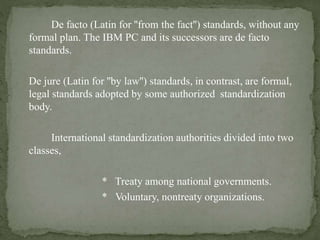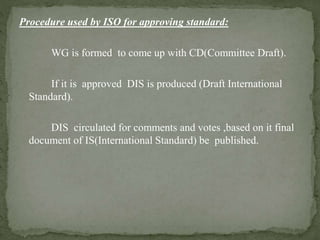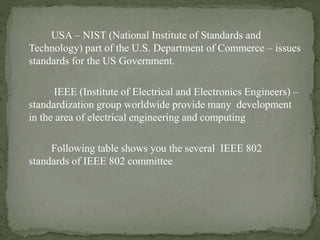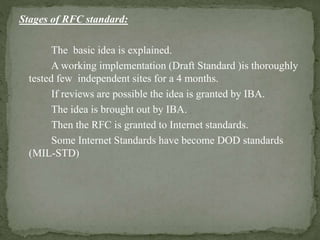Network standardization
- 2. To outcome the own ideas and products in network world it is possible by coordination and support of some network standards. Standards are mainly used to market the products. Two categories of standard: * de facto * de jure
- 3. De facto (Latin for ''from the fact'') standards, without any formal plan. The IBM PC and its successors are de facto standards. De jure (Latin for ''by law'') standards, in contrast, are formal, legal standards adopted by some authorized standardization body. International standardization authorities divided into two classes, * Treaty among national governments. * Voluntary, nontreaty organizations.
- 4. The United States, which has 1500 separate, privately owned telephone companies. In 1984 ,AT&T provide long-distance service, although now in competition with other companies . It provided telephone service to about 80 percent of America's telephones In 1865, Europe lead the way to today's ITU (International Telecommunication Union)ex: telegraphy. In 1947, ITU became an agency of the United Nations
- 5. ITU has three main sectors: * Radio communications Sector (ITU-R). * Telecommunications Standardization Sector (ITU-T). * Development Sector (ITU-D). ITU-R ,allocating radio frequencies worldwide. ITU-T, telephone and data communication systems From 1956 to 1993,ITU-T was known as CCITT Acronym: CCITT French name: Comite Consultatif International Télégraphique et Téléphonique Both ITU-T and CCITT concern commendation in the area of telephone and data communications.
- 6. ITU-T has four classes of members: National governments. Sector members. Associate members. Regulatory agencies. ITU-T has 200 governmental members, 500 sector members . Associate members are smaller organizations that are interested in a particular Study Group(14 study group who did real work from telephone billing to multimedia services). Regulatory agencies are the people who guard telecom business The task of ITU-T is to make commendation to telephone, telegraph, and data communication Interfaces
- 7. ISO (International standards Organization ) produce International standard.ISO is a voluntary nontreaty organization founded in 1946. It contains 89 national standards organizations of the 89 member countries as its members. ISO has nearly 200 Technical committees (TC) based on various subjects .Each TC has a Sub Committee(SC). Each SC has divided into several Work Group(WG)(real work is done by WG). ISO is a member of ITU-T. The U.S. representative in ISO is ANSI (American National Standards Institute).
- 8. Procedure used by ISO for approving standard: WG is formed to come up with CD(Committee Draft). If it is approved DIS is produced (Draft International Standard). DIS circulated for comments and votes ,based on it final document of IS(International Standard) be published.
- 9. USA – NIST (National Institute of Standards and Technology) part of the U.S. Department of Commerce – issues standards for the US Government. IEEE (Institute of Electrical and Electronics Engineers) – standardization group worldwide provide many development in the area of electrical engineering and computing Following table shows you the several IEEE 802 standards of IEEE 802 committee
- 11. The worldwide Internet has own standardization mechanism, it is different from ITU-T and ISO. In 1983 informal committee created by DOD to watch over ARPANAET was IAB (Internet Architecture Board) . IAB ‘s Task force members (10 members) take part in resolving the important issues. Feedback to DOD and NSF was produced at the meeting organized by IAB.
- 12. When a product need a standard: IAB members announce the change. The graduate student implement the software effort. RFC (Request For Comments) technical report play a major part. This RFC is fetched from online by this site www.ietf.org/rfc by anyone . There are more then 3000 RFC are available.
- 13. Stages of RFC standard: The basic idea is explained. A working implementation (Draft Standard )is thoroughly tested few independent sites for a 4 months. If reviews are possible the idea is granted by IBA. The idea is brought out by IBA. Then the RFC is granted to Internet standards. Some Internet Standards have become DOD standards (MIL-STD)
- 14. THANKYOU













